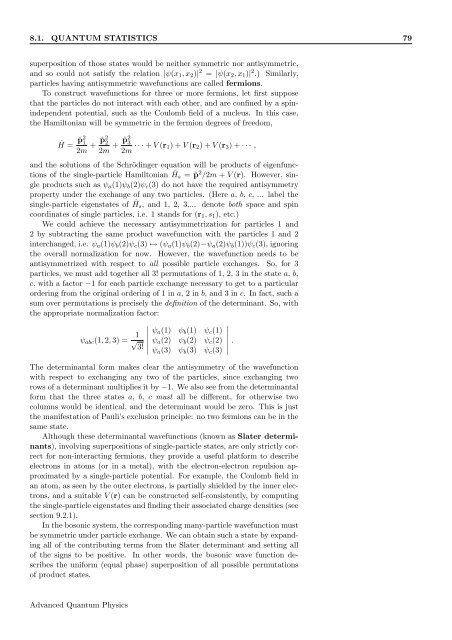Identical Particles - Theory of Condensed Matter
Identical Particles - Theory of Condensed Matter
Identical Particles - Theory of Condensed Matter
Create successful ePaper yourself
Turn your PDF publications into a flip-book with our unique Google optimized e-Paper software.
8.1. QUANTUM STATISTICS 79<br />
superposition <strong>of</strong> those states would be neither symmetric nor antisymmetric,<br />
and so could not satisfy the relation |ψ(x1,x2)| 2 = |ψ(x2,x1)| 2 .) Similarly,<br />
particles having antisymmetric wavefunctions are called fermions.<br />
To construct wavefunctions for three or more fermions, let first suppose<br />
that the particles do not interact with each other, and are confined by a spinindependent<br />
potential, such as the Coulomb field <strong>of</strong> a nucleus. In this case,<br />
the Hamiltonian will be symmetric in the fermion degrees <strong>of</strong> freedom,<br />
ˆH = ˆp2 1<br />
2m + ˆp2 2<br />
2m + ˆp2 3<br />
2m · · · + V (r1)+V (r2)+V (r3)+· · · ,<br />
and the solutions <strong>of</strong> the Schrödinger equation will be products <strong>of</strong> eigenfunctions<br />
<strong>of</strong> the single-particle Hamiltonian ˆ Hs = ˆp 2 /2m + V (r). However, single<br />
products such as ψa(1)ψb(2)ψc(3) do not have the required antisymmetry<br />
property under the exchange <strong>of</strong> any two particles. (Here a, b, c, ... label the<br />
single-particle eigenstates <strong>of</strong> ˆ Hs, and 1, 2, 3,... denote both space and spin<br />
coordinates <strong>of</strong> single particles, i.e. 1 stands for (r1,s1), etc.)<br />
We could achieve the necessary antisymmetrization for particles 1 and<br />
2 by subtracting the same product wavefunction with the particles 1 and 2<br />
interchanged, i.e. ψa(1)ψb(2)ψc(3) ↦→ (ψa(1)ψb(2)−ψa(2)ψb(1))ψc(3), ignoring<br />
the overall normalization for now. However, the wavefunction needs to be<br />
antisymmetrized with respect to all possible particle exchanges. So, for 3<br />
particles, we must add together all 3! permutations <strong>of</strong> 1, 2, 3 in the state a, b,<br />
c, with a factor −1 for each particle exchange necessary to get to a particular<br />
ordering from the original ordering <strong>of</strong> 1 in a, 2 in b, and 3 in c. In fact, such a<br />
sum over permutations is precisely the definition <strong>of</strong> the determinant. So, with<br />
the appropriate normalization factor:<br />
ψabc(1, 2, 3) = 1<br />
√ 3!<br />
<br />
<br />
<br />
<br />
<br />
<br />
ψa(1) ψb(1) ψc(1)<br />
ψa(2) ψb(2) ψc(2)<br />
ψa(3) ψb(3) ψc(3)<br />
The determinantal form makes clear the antisymmetry <strong>of</strong> the wavefunction<br />
with respect to exchanging any two <strong>of</strong> the particles, since exchanging two<br />
rows <strong>of</strong> a determinant multiplies it by −1. We also see from the determinantal<br />
form that the three states a, b, c must all be different, for otherwise two<br />
columns would be identical, and the determinant would be zero. This is just<br />
the manifestation <strong>of</strong> Pauli’s exclusion principle: no two fermions can be in the<br />
same state.<br />
Although these determinantal wavefunctions (known as Slater determinants),<br />
involving superpositions <strong>of</strong> single-particle states, are only strictly correct<br />
for non-interacting fermions, they provide a useful platform to describe<br />
electrons in atoms (or in a metal), with the electron-electron repulsion approximated<br />
by a single-particle potential. For example, the Coulomb field in<br />
an atom, as seen by the outer electrons, is partially shielded by the inner electrons,<br />
and a suitable V (r) can be constructed self-consistently, by computing<br />
the single-particle eigenstates and finding their associated charge densities (see<br />
section 9.2.1).<br />
In the bosonic system, the corresponding many-particle wavefunction must<br />
be symmetric under particle exchange. We can obtain such a state by expanding<br />
all <strong>of</strong> the contributing terms from the Slater determinant and setting all<br />
<strong>of</strong> the signs to be positive. In other words, the bosonic wave function describes<br />
the uniform (equal phase) superposition <strong>of</strong> all possible permutations<br />
<strong>of</strong> product states.<br />
Advanced Quantum Physics<br />
<br />
<br />
<br />
<br />
<br />
.

















